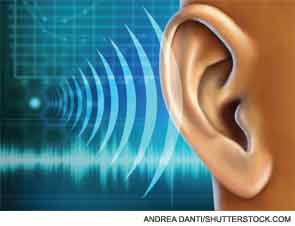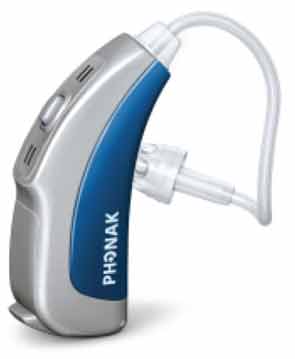Explore This Issue
January 2014
The treatment of single-sided deafness (SSD) has come a long way in the last decade, with wireless technology-enabled hearing aids and osseointegrated devices exemplifying only two of the many noteworthy advances. These newer treatment options have opened up a much wider base of patients with SSD who can benefit.
“The attitude used to be, sure, you’re deaf in one year, but you still have another functional ear. Deal with it—go off and live your life,” said David M. Baguley, MBA, PhD, head of service: audiology/hearing implants at Cambridge University Hospitals, in Cambridge, England. But such an attitude downplays the significant psychosocial handicap these patients struggle with daily, Dr. Baguley added (See “Psychosicial Aspects of SSD,” below). Given the sophistication and effectiveness of the newer SSD interventions, “there’s simply no need to let that continue; we can help patients find an effective intervention.”
One of the latest developments in the treatment of SSD is the SoundBite, from SonitusMedical, which employs a behind-the-ear (BTE) microphone unit worn on the patient’s deaf side. The BTE unit uses a digital signal processor and a wireless chip to transmit detectedsound to a custom-fit, in-the-mouth (ITM) device. Placed on either the left or right back molars, the ITM device converts the sound transmissions into vibratory energy, which then flows via bone conduction to the inner ear on the contralateral side.
Richard K. Gurgel, MD, assistant professor in the division of otolaryngology-head and neck surgery at the University of Utah Health Care in Salt Lake City, co-authored a recent study of the SoundBite (Laryngoscope. 2013;123:2807-2812). The study, which was funded by Sonitus Medical, followed 34 patients for six months and used validated self-assessment tests to measure patient satisfaction with the device. Results from the Abbreviated Profile of Hearing Aid Benefit patient questionnaire were particularly impressive, said Dr. Gurgel, who had no other funding or financial relationships with Sonitus Medical to disclose. “Each of the major subscores we looked at—ease of communication, background noise, reverberation, and global benefit—improved significantly when we compared them to baseline scores,” he said.
A related patient self-assessment test also yielded very favorable results. Longer-term follow-up data will be presented at the American Otological Society Annual Meeting this spring.
Dr. Gurgel did note some potential limitations, including the difficulty of eating with the device in place. But, he said most patients adapt either by getting used to the sensation or removing the device prior to eating, much like a dental retainer. Additionally, 12 patients reported acoustic feedback, “similar to when a hearing aid whistles,” he said. “But about half of those patients’ feedback resolved when we adjusted the device.”
A Nonsurgical Alternative
Another option for SSD is osseointegrated bone conduction systems, also known as bone-anchored hearing aids (BAHA). “I’m a fan of osseointegrated devices,” Dr. Gurgel said. “I’ve certainly used them for years in my own practice and training.” The problem, he said, is that not all SSD patients are good candidates for BAHA.
For example, some patients are averse to having an implanted post visible through their skin. In other cases, patients may not want to risk one of the downsides of BAHA surgery, the potential for developing skin overgrowth around the post or infections, which occurs in up to 22% of patients (Otolaryngol Head Neck Surg. 2008;139:829-832). In patients who are averse to osseointegrated devices because of the potential for such effects, “the SoundBite is a viable alternative that can effectively deliver sound into the inner ear,” Dr. Gurgel said.
For SSD patients who can’t afford the out-of-pocket expense of the SoundBite, which Dr. Gurgel said is about $7,000, other options are certainly available. If BAHA is a consideration, he suggests one of the newer-generation systems that carry a lower risk for skin problems related to the device. Cochlear Corp., for example, has developed the DermaLock system, which employs a hydroxyapatite ring set around an extended, 8.5-mm abutment. In a recent study, rates of infection, skin overgrowth, and the need for revision surgery related to wound complications were significantly decreased in patients
implanted with the 8.5-mm abutment when compared with a retrospective historical cohort of patients implanted with a 5.5-mm abutment, the authors reported (Laryngoscope. Published online ahead of print September 23, 2013; doi: 10.1002/lary.24399).

Next Up: Cochlear Implants for SSD?
Researchers at the University of Iowa Hospitals and Clinics, in Iowa City, just published a trial of cochlear implantation (CI) in patients with unilateral hearing loss (Otol Neurotol. 2013;34:1681-1687). The study’s positive results may well be a game-changer in the management of selected SSD patients, according to co-author Bruce J. Gantz, MD, professor and head in the department of otolaryngology-head and neck surgery.
The study included 29 patients with SSD who underwent CI. In 10 of the patients, the hearing loss was due to Meniere’s disease and was accompanied by recalcitrant vertigo. A labryinthectomy was done in the latter group during the implant procedure, as well as in two patients from the larger group.
Several measures of auditory function improved significantly in the 19 patients who were available for up to a one-year follow-up. “One of the more surprising findings in both groups was that many of the patients were able to localize sound,” said Dr. Gantz. “This is not generally possible with bone conduction devices or CROS [contralateral routing of sound] hearing aid technology. There was also improved performance in noise [discrimination] with binaural hearing.”
Overall, he added, the patients with vertigo “were the most satisfied, because they were free of the recurring spells of dizziness and also had significant return of hearing in an ear that had not heard for several years.”
Dr. Gantz added, “We need much more clinical research with SSD and CI before we can identify the best population for this intervention.”
Trial First, Then Decide
The SoundBite, CI surgery, and the latest generation of BAHA devices aren’t the only choices clinicians have to weigh as potential SSD interventions. One sometimes neglected option is CROS hearing aids, albeit those enhanced with the latest signal processing equipment and other high-tech refinements, according to Charles E. Bishop, AuD, an assistant professor in the department of otolaryngology and communicative sciences at the University of Mississippi Medical Center in Jackson. Coupled with a traditional hearing aid, the CROS device becomes a BiCROS application and can amplify sound for an impaired ear as well as receive input from the “dead” ear, meeting the needs of a large percentage of SSD patients.
Why, then, are current hearing aid options sometimes overlooked? “It all comes down to what we consider to be the gold standard of how to manage these patients,” said Dr. Bishop. “Despite the wonderful advancements in BAHA and similar implantable devices, we feel that a very thorough patient trial with a non-surgical approach is a good [place to] start. But we recommend using the best new hearing aid technology as the basis for the trial, and not some archaic device stored in a cabinet.”
Does testing with outmoded devices happen very often? “I hope not,” Dr. Bishop said. “Still, practices have financial constraints; it can be hard to have expensive devices on hand for demonstration purposes. But it’s worth the effort in terms of patient satisfaction and outcomes.”
He added that his team always tries to demo CROS and/or BiCROS aids that have wireless features, so that patient concerns over cosmetics and the stigma associated with older wired hearing aids can be overcome. The trials, which last for several weeks, include detailed patient counseling on how to use the devices. “Tweaking” of the signal processing settings is done as needed. When such an approach is taken, Dr. Bishop said, patients are often very pleased with the results, obviating the need for BAHA and other more invasive, surgical procedures.
Given the recent advancements in hearing aid technology, he noted, that’s not a surprising outcome. “The CROS/BiCROS hearing aids we are working with are light years ahead of where they used to be,” he said. Some companies, for example, are using a prescriptive approach to address the needs of individual patients. “Whether a patient is deaf in one ear or has additional loss in the better functioning ear—a scenario we frankly see a lot more frequently in our clinic than pure SSD—there are notable wireless hearing aid options that may do the job,” he added.
Does a clinician still need to look to the literature for some guidance in choosing an SSD intervention? “Of course,” Dr. Bishop said. “But data can be misleading; it is notoriously difficult to do comparative studies of hearing aids versus implanted devices due to selection bias and other poorly controlled patient variables. With a two- to three-week trial of hearing aids, in contrast, you can’t really go wrong as a baseline strategy. The information you glean is absolutely invaluable.”
Dr. Baguley echoed the wisdom of such an approach. “In our hands, we almost always go with a CROS fitting as a first step to see if a patient with SSD will commit to wearing the device,” he said. “You really need to see if they are motivated enough to go with a technological solution. If they don’t tolerate CROS or don’t get the benefit they need, then and only then would we consider a move to BAHA or some other, more involved procedure.”
In The Netherlands, a Similar Approach
Myrthe K.S. Hol, PhD, MD, a widely published expert on hearing loss interventions from Radboud University Medical Center, Nijmegen, the Netherlands, also recommends nonsurgical trials for SSD patients. She demos not only CROS or BiCROS hearing aids but also BAHA devices that are worn on a headband, because in her clinical experience and research, the latter devices also have the potential for improving hearing thresholds and quality of life in selected patients (Eur Arch Otorhinolaryngol. 2010;267:889-896).
“We do think it is extremely important to have a very long period (at least two weeks) of headband testing before deciding on a given intervention, especially in ases of SSD,” Dr. Hol said. In the case of BAHA, “this is particularly useful, because in some cases, as effective as these devices can be, some patients still decide that they are not working for them. That is information you want to have before you actually subject them to BAHA surgery.”
Still, some patients do reject the devices after implantation. Dr. Hol and her team have implanted more than 100 SSD patients with BAHAs over the past several years. “We recently asked them whether they are still using the device after a mean follow-up of five years and found that, on average, 17% of the patients are no longer using the devices. In a smaller group of patients we’ve followed for up to 10 years, the drop-out rate approaches 30%.”
Are those rates high? “It’s hard to say; there is very little published data on discontinuation of treatment in these patients,” Dr. Hol said. She added that the rate is partly due to a heterogenous patient mix: Some had congenital while others had acquired SSD, and the former group tends to judge hearing-aid interventions more critically because they already have developed considerable coping skills before being fitted.
Still, “that drop-out suggests to me that 10 years ago, perhaps we might have overlooked spcific items during pre-operative counseling of these patients about the benefits or expectations of BAHA in SSD. Or, we did not do enough pre-surgical trials of the hearing aids. We need to learn from that experience: These are very expensive devices, requiring fairly involved surgery and repeated adjusting and follow-up, to end up sitting on a shelf.”
David Bronstein is a freelance writer based in New Jersey.
Leave a Reply